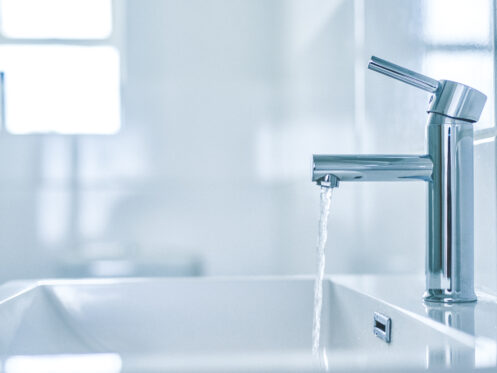The faucets in your Glendale, AZ home play more of a role in your health than you may realize. They can also save you money. However, calcium buildup on your faucets can become a problem and cause different issues, such as health problems, clogging, and damage to the faucet.
Why Does Calcium Accumulate on Faucets?
Limescale causes calcium buildup on faucets, which is the result of hard water. Hard water is full of minerals, such as magnesium and calcium. When hard water travels through your plumbing system, it’s likely this water will encounter the surface of the faucets in your home and leave remnants of mineral deposits. These mineral deposits form a chalky white residue known as limescale. This calcium often collects around the base of the faucet, where it connects with the sink deck or counter.
What Problems Can Calcium Build Up Cause?
Calcium buildup on your faucets can cause a variety of issues. The sooner you remove the calcium, the sooner you can mitigate or prevent certain issues.
Reduced Water Flow
Calcium buildup can narrow the water flow coming from the faucet, resulting in a decrease in water pressure. Low water pressure can cause other issues, including difficulty using plumbing fixtures, plumbing leaks, and experiencing significant plumbing issues in the future.
Premature Wear
The mineral deposits that cause limescale can corrode a metal surface, including your faucets. This corrosion can shorten the lifespan of your faucet, causing different problems, such as rust, stubborn stains, and other issues.
Stubborn Stains
Calcium buildup leaves white deposits on different faucet parts, especially the spouts. These deposits make it more difficult to clean faucets. Severe calcium buildup may require the expertise of a professional plumber.
Metal Corrosion
When a metal faucet erodes, you may experience other issues, such as reduced water pressure, leaks, and entire faucet failure. The corrosion of metal can also cause different health risks, such as unwanted minerals in your water and exposure to lead and copper.
What Are the Benefits of Removing Calcium Buildup From Faucets?
When you remove calcium buildup from your faucets, you can reap the following benefits:
- Cleaner water
- No mineral deposits that clog the plumbing
- Cleaner faucets
- Increased lifespan for your faucets
- Optimal performance
- Reduced water expenses
- Improved faucet appearance
How to Remove Calcium Buildup on Your Faucet
You can remove calcium buildup from your faucet in different ways. This will increase their longevity and improve how they look and function.
Vinegar Solution
Vinegar takes care of calcium deposits by breaking them down. You will need one part vinegar and two parts water to make the vinegar solution. You can apply this solution using a clean, soft cloth. Allow the cloth to soak up the solution, and let the cloth sit on the faucet for at least 30 minutes. After 30 minutes, rinse the faucet using clean water.
Lime Removal Agents
There are specific products that are designed to remove limescale. Follow the instructions the manufacturer provides on the bottle. You’ll follow many of the same steps if you were using a vinegar solution. Wipe this product off using a clean cloth. Depending on how severe the calcium deposits are, you may need a toothbrush to agitate them for removal.
The Baking Soda Method
If you’re using the baking soda method, create a paste with baking soda by adding a little water at a time. Once you make the paste, apply it to the faucet and leave it alone for at least 15 minutes. If your faucet has excessive dirt on it, it’s best to let the paste sit overnight. In the morning, use a toothbrush to remove the paste, and rinse the faucet with water.
Use CLR
CLR is a product that is specifically designed to remove the buildup of calcium, rust, and lime. This product is safe to use on metal surfaces, so you don’t have to worry about faucet damage. To use this chemical solution, mix one part of it with four parts water.
You’ll need to apply the CLR and water mixture to the affected areas of your faucet using a cloth or sponge and scrub gently. After removing the calcium, rinse the area with clean water and dry it with a clean, soft cloth. If you currently have hard water, you may want to use CLR more frequently to prevent severe calcium buildup.
How to Prevent Calcium Buildup on Your Faucets
Preventing calcium buildup on the faucets in your home is easier than it sounds. There are different steps you can take.
Water Filtration System
Water filtration systems remove minerals, such as calcium and salt, from your water before they have time to accumulate on your fixtures. Different types of water filtration systems are available, so you’ll need to determine which filter system will meet your home’s needs.
These filtration systems use the ion exchange process to help eliminate magnesium and calcium from the water in your home. This process will activate when hard water meets the resin beads in the mineral tank. The resin beads are charged with sodium ions, giving them a negative charge. This negative charge will attract positive charges of magnesium and calcium minerals and attach to the beads. Once attached, these minerals are removed from the water.
After removing these minerals, you have softened the water flowing from the mineral tank through the pipes in your home to your faucets. You can enjoy cleaner faucets and cleaner water, which will improve the lifespan of your appliances.
Cleaning Your Faucets Regularly
Cleaning your faucets regularly can prevent calcium buildup. Make sure you’re doing so by using a soft sponge or cloth and a mild soap to prevent damage. For tough and stubborn stains, it’s best to have a professional plumber assess the buildup and determine the appropriate method of action.
Drying Your Faucets
You can dry your faucets to ensure there is little to no calcium buildup. Water can cause calcium to accumulate. Because of this, it’s important to remove excess water from the faucet’s surface. You can remove excess water using a soft cloth.
Replacing Your Faucets
Having hard water can mean that you’ll need to replace your faucets more often than you would if you didn’t have hard water. The accumulation of calcium can damage the finish on the faucet and cause it to malfunction. If your faucets are showing signs of wear and tear, you may want to consider replacing them. It’s a good idea to ensure that your new faucets are made from a material that is resistant to hard water damage, so you won’t have to replace them as often.
For severe calcium buildup, especially if there is a buildup on multiple faucets and fixtures, it’s best to seek the expertise of a professional plumber. Here at Bumble Bee Plumbing, we specialize in plumbing, water heaters, and drains. We proudly serve Anthem, Glendale, Sun City West, and the surrounding areas. Contact our experts today to learn how we can help!


